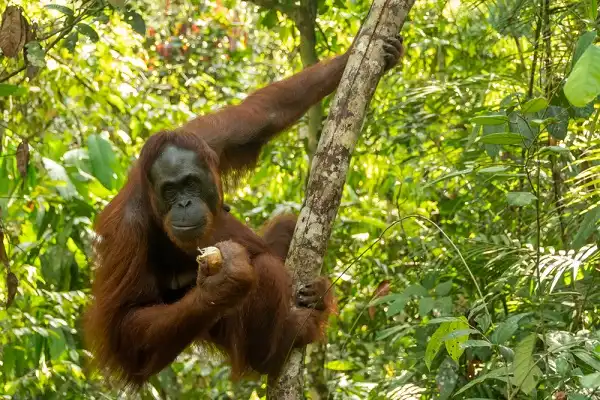If you’re looking for a fascinating animal to admire, consider taking the time to learn more about orangutans. These intelligent primates live in the rainforest canopy of Indonesia and Malaysia, and they are one of the most endangered species on Earth. From their remarkable dexterity while leaping tree-to-tree, and their careful nesting habits that can be seen at night, these creatures may just evoke admiration like no other when you get to witness them up close! To gain an even better understanding of these gentle giants’ lives as well as what we can do as human beings to protect them, keep reading today’s post!

Orangutan Description
Orangutans are a species of great apes native to the rainforests of Indonesia and Malaysia. They are known for their unique reddish-brown hair and their exceptional intelligence. In fact, they are one of the smartest animals on the planet, with an ability to learn and communicate that rivals even that of chimpanzees. The physical characteristics of orangutans are also impressive. They have long, powerful arms and an opposable thumb that allows them to grip tightly onto tree branches. This enables them to move swiftly and gracefully through the forest canopy.
Orangutan Habitat
Orangutans are indigenous to the rainforests of Indonesia and Malaysia, where they lead a largely arboreal lifestyle in the high canopy. These majestic creatures are predominantly found in peat swamps, swamp forests, and riparian forests, which provide the ideal habitat for their survival. Unlike some other primates, orangutans prefer an isolated lifestyle, occupying mutually exclusive territories that overlap only briefly with others of their kind. Their survival is critically linked to the forests, which provide them with the food sources and nests they need to survive. Despite the vital importance of old-growth forests to the survival of orangutans, human activities such as habitat destruction, logging, mining, and palm oil production are decimating their habitat at an alarming rate. In fact, over the past decade alone, the orangutan population has declined by as much as 50%. If these activities continue unabated, orangutans are at great risk of extinction in the wild. It is our responsibility, as global citizens, to take action to preserve the natural environment and protect these amazing creatures. Conservation efforts such as reforestation and habitat protection can help conserve orangutan populations and improve their chances of survival. It is essential that individuals, companies, and governments work together to reduce the impact of human activities on the forests, ensuring that the orangutan’s home is secure for generations to come.
Orangutan Diet
Orangutans are known for their unique and varied diet, which includes over 400 different food items. While they are primarily frugivorous, meaning they eat mostly fruit, their diet also includes leaves, flowers, bark, insects, and occasionally small animals like birds and rodents. Fruit, however, makes up the majority of an orangutan’s diet, with over 70% of their caloric intake coming from this food source. They will eat a wide range of fruit, including figs, durians, lychees, and jackfruit, among others. In fact, they have been known to consume up to 200 different species of fruit within a single forest. Interestingly, orangutans have been observed showing a preference for certain types of fruit at different times of the year. During the wet season, when the fruit is more abundant, they tend to eat a wider variety. However, during the dry season, when food sources are limited, they will focus on highly nutritious fruits like figs and durians. In addition to fruit, orangutans also consume leaves, which make up about 25% of their diet. They have been observed eating over 100 different species of leaves, with a preference for tender, young leaves that are easier to digest. Leaves provide a valuable source of protein, fiber, and other nutrients.

Orangutan Size
Orangutans are the largest arboreal mammal in the world, with males reaching a height of up to 1.5 meters and weighing as much as 120 kilograms. Females are smaller, with a height of up to 1 meter and a weight of up to 50 kilograms. One of the defining features of orangutans is their long, powerful arms, which are specially adapted to life in the trees. Their arms are longer than their legs, reaching up to 2.25 meters in length, and are covered in shaggy, reddish-brown hair. This hair serves as a protective layer, helping to cushion their falls and prevent injury. Orangutans also have broader chests than other apes, which are essential for climbing and swinging through the trees. Their feet are also prehensile, meaning they can grasp branches with their toes to help maintain their balance and hold onto their food while eating.
Orangutan Lifespan
Orangutans have a relatively long lifespan compared to other primates, with wild individuals living up to 35-45 years on average. In captivity, they have been known to live up to 60 years or more. However, the actual lifespan of an orangutan can be affected by various environmental and biological factors. For example, habitat destruction and fragmentation, as well as hunting and poaching, can greatly reduce the population of orangutans and limit their access to food and resources. This can lead to increased competition for food and mates, which can place additional stress on their bodies. In addition to external factors, orangutans can also suffer from various health issues that can impact their lifespan.
For example, they can contract diseases such as tuberculosis and hepatitis from humans, which can be fatal. They may also experience dental problems, respiratory issues, and other ailments that can affect their overall health and well-being. Despite these challenges, there are efforts underway to protect orangutans and their habitats, such as rehabilitation and release programs, captive breeding initiatives, and conservation projects aimed at preserving their natural environment. By supporting these efforts, we can help ensure that orangutans have a better chance of living long, healthy, and fulfilling lives in the wild.
Orangutan Behavior
Orangutan behavior is fascinating and complex, with many unique characteristics that set them apart from other primates. One of the most notable behaviors of orangutans is their solitary lifestyle. Unlike other great apes, such as chimpanzees and gorillas, orangutans typically live alone, only coming together to mate. This behavior is believed to be linked to the scarcity of resources in the rainforest, which leads to intense competition between orangutans. By living alone, they are able to reduce their competition for food and other resources, increasing their chances of survival. Orangutans also have developed a wide range of vocalizations and gestures to communicate with each other, including a variety of grunts, screams, and various facial expressions.
They may use these vocalizations and gestures to express aggression, dominance, or to attract a mate. Another fascinating behavior of orangutans is their use of tools. They have been observed using sharp sticks to extract insects from crevices, or using leaves to cover their bodies as protection from the rain. This ability to use tools is a strong indication of their intelligence and problem-solving skills. In addition to their unique behaviors, orangutans have also been observed exhibiting emotional complexity, including grief. Researchers have witnessed female orangutans mourning the loss of their infants, carrying their dead babies for days or even weeks.

Orangutan Speed
Orangutans are known for their fascinating behavior and unique characteristics, including their remarkable speed. While they are not as fast as other primates like chimpanzees or gorillas, they are still incredibly quick and agile. In fact, orangutans are capable of moving through trees at a speed of up to 25 miles per hour, using their long arms to swing from branch to branch with ease. This mode of movement is known as brachiation, and it requires a great deal of strength and coordination. One of the most impressive aspects of orangutan speed is their ability to cover huge distances in a short amount of time. This is especially important in their natural habitat, the rainforest, where they must travel long distances to find food and mates. To achieve this speed, orangutans have developed a number of unique adaptations. For example, they have longer arms than other primates, which allows them to swing further between trees. They also have a stronger grip, which helps them to hold onto branches even when they are moving at high speeds.
Orangutan Hunting
Orangutan hunting is a significant threat to the survival of these incredible creatures. Although hunting orangutans is illegal, it continues to occur in some parts of the world due to the demand for their meat, as well as the pet trade. One of the main factors driving orangutan hunting is the belief that consuming meat can provide health benefits or increase male fertility. This belief is not supported by scientific evidence and is instead putting the survival of these remarkable creatures at risk. In addition to the direct impact of hunting on orangutan populations, it also contributes to the destruction of their habitat. As hunters clear areas of the forest, they are destroying the natural environment that is necessary for orangutans and many other species to survive. Furthermore, the capture of young orangutans for the pet trade is also having a devastating impact on these creatures. Infants are often taken from their mothers, causing immense emotional distress and disrupting the social structures of these highly intelligent animals.
Orangutan Social Behavior and Communication
Orangutans are highly intelligent and social creatures. They possess complex communication skills that enable them to interact with each other in a variety of ways. For example, they use vocalizations such as long calls, grunts, and screams to convey messages such as warning signals or to attract potential mates. They also use body languages, such as facial expressions and posture, to express emotions and intentions. In addition to vocalizations and body language, orangutans use a range of other communication methods. For instance, they create nests in trees every night, which serve as homes for them. The nests also serve as markers to other orangutans, indicating their presence in the area. This is a vital component of their social behavior, helping to keep them connected with their family members and neighbors. Orangutans are also known for their unique grooming behavior. They not only groom themselves but also groom each other. Grooming serves not only as a way to maintain hygiene but also as a bonding activity between individuals. Grooming may be a way of maintaining social bonds and resolving conflicts within the group.

Conclusion
Orangutans are remarkable creatures with incredible speed and agility, but their survival is threatened by the destruction of their natural habitat and hunting. In order to protect these incredible species, it is essential that we take action to preserve the rainforest and prevent further destruction. Through education and conservation efforts, we can ensure that orangutans are able to continue to thrive in their natural environment.
Frequently Asked Question

